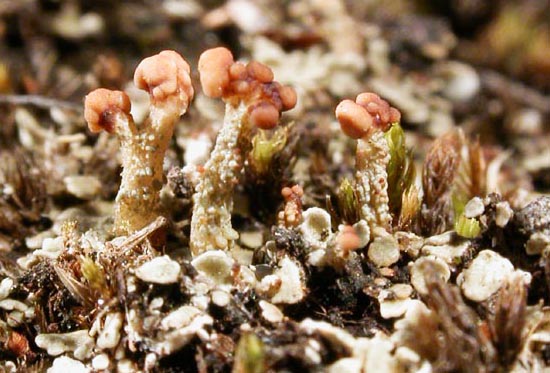Cladonia peziziformis
Description & Identification
(Adapted from Chambers, 2003)

Photo: Alan Orange
C.peziziformis forms cushions of loosely aggregated, small, rounded-auriculate, greyish-green squamules. It could be confused with the juvenile squamules of a wide range of other heathland Cladonia species but these tend to be more variously marginally incised (sometimes with sorediate or granular-edges), sometimes brownish, erect or decumbent, and less organised. When fresh in the field its squamules can have something of the look of a diminutive grey Omphalina hudsoniana. When fertile it is unmistakeable. It most closely resembles C.cariosa but that species occurs on dry and free-draining, sandy ground, on calcareous substrates, and often on metal-polluted soils. The podetia of C.cariosa are taller ((0.5-) l-2(-2.5)cm), more strongly lacerated and have branched corymbose clusters of dark brown apothecia. In C.peziziformis the podetia are shorter (to ca. lcm) with a single turban-like, paler brown apothecium, or weakly branched with l-2(-3) terminal apothecia.

Drawings: Alan Orange
C.peziziformis is Pd+red, K- (or murky brown); C.cariosa is pd- or +weak yellow, K+y (atranorin). Squamules of both species can have large, sessile, dark brown-black, barrel-like pycnidia, preceding the formation of podetia.
Records from Wales
Records from Wales (some older and poorly-localised records have been ommitted):
| Location | Grid Reference | Last Rec'd | Recorder | SSSI |
| Anglesey: South Stack | SH208819 | 2007 | S.P. Chambers | Yes |
| Caernarfon:Mynydd Garngwch | SH374425 | 2002 | S.P. Chambers | No |
| Pembs: Dowrog Common | SM770269 | 1989 | A.O. Orange | Yes |
NBN Taxon Key
NBNSYS0000018391
- Read more about Cladonia peziziformis
- Log in to post comments
